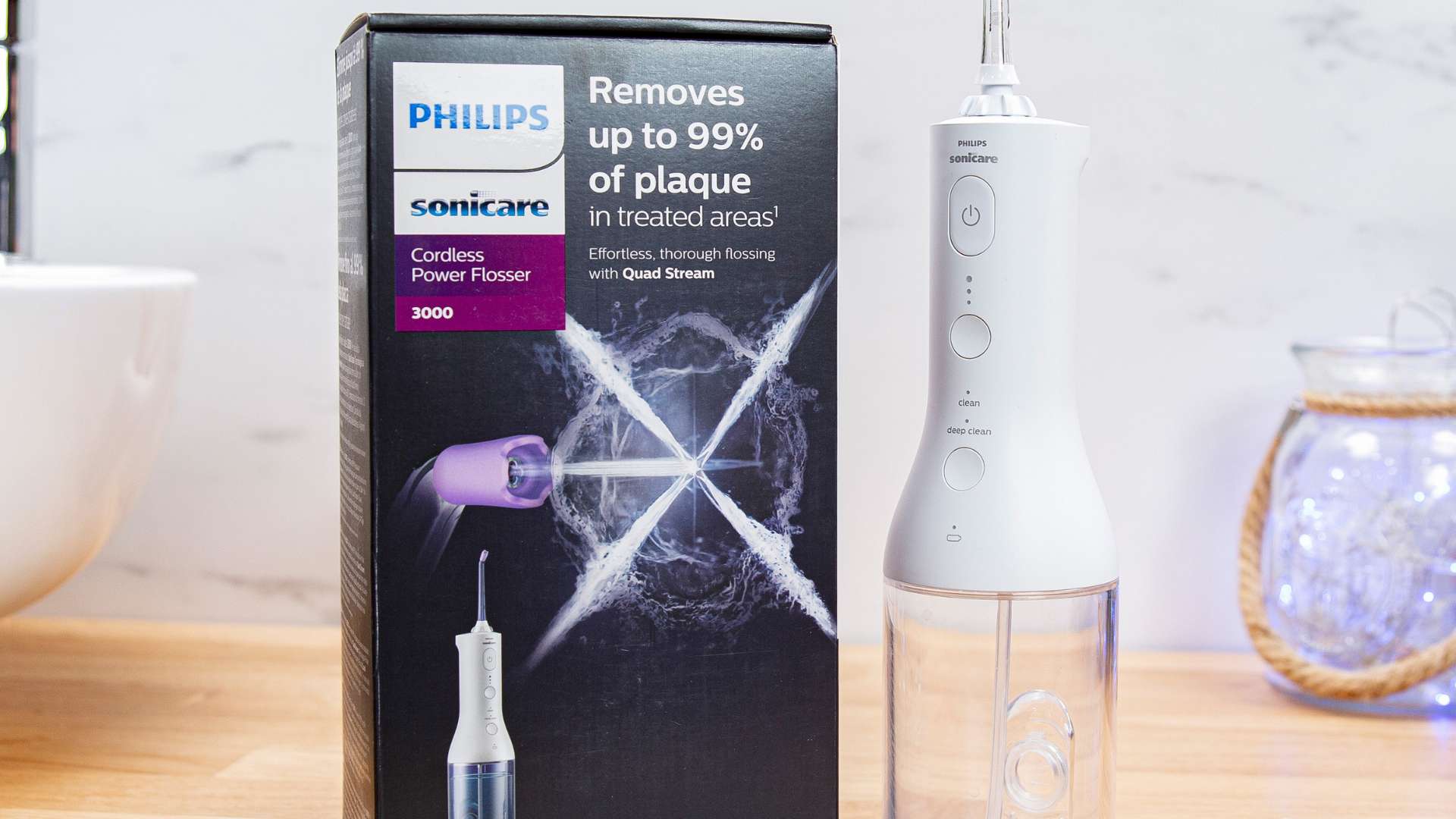
Editor’s note: different power adapters
It’s come to our attention in January 2024 that Philips has introduced versions of the Cordless Power Flosser 3000 that use a ‘small plug cable’ rather than USB Type-C connector as shown in this article.
In all instances, the power cable has a USB Type-A connector at the other end. Product listings don’t necessarily make it very clear which one you are getting.
Part codes for the variants with what Philips calls ‘Fast universal charging with USB-A to Small Plug cable’ include: HX3826/31, HX3826/33, HX3826/23, HX3826/21 & HX3826/24.
The exact reasons for this change are not known. We await further information from Philips.
One of the best cordless flossers that performs as well as you would expect of a Sonicare product
It lacks some textured grip on the handle and the nozzle isn’t the easiest to rotate, but this is more than made up for by the excellent cleaning performance and other features it offers.
The built-in pacer and large 250ml water tank are useful, but the costly replacement nozzles are inexcusable.
Overall the Cordless Power Flosser 3000 is an excellent water flosser and takes the challenge to market leader Waterpik.

3 pressure/intensity settings |
Expensive replacement nozzles |

Built-in timer/pacer to encourage even flossing |
The nozzle is a bit difficult to rotate |

USB Type C charger |
Lacks gripping points |

It’s bulky and not the most grippy, but it’s lighter than the competition
If you haven’t handled a water flosser before, you might be somewhat surprised by the size.
Despite cordless models being the more travel-friendly option, they are a bit bulky, due to the very nature of what they are. If you want to travel light, you probably won’t be including the Power Flosser 3000 in your bag.
An all-plastic construction, the 3000 is wider at the base, thinning towards the top of the unit. This makes it easier to hold, albeit there is a lack of textured surfaces to assist in getting a secure grip. Thankfully you don’t feel like you have a cramped hold of the device like you do on the Waterpik Cordless Select, for example.
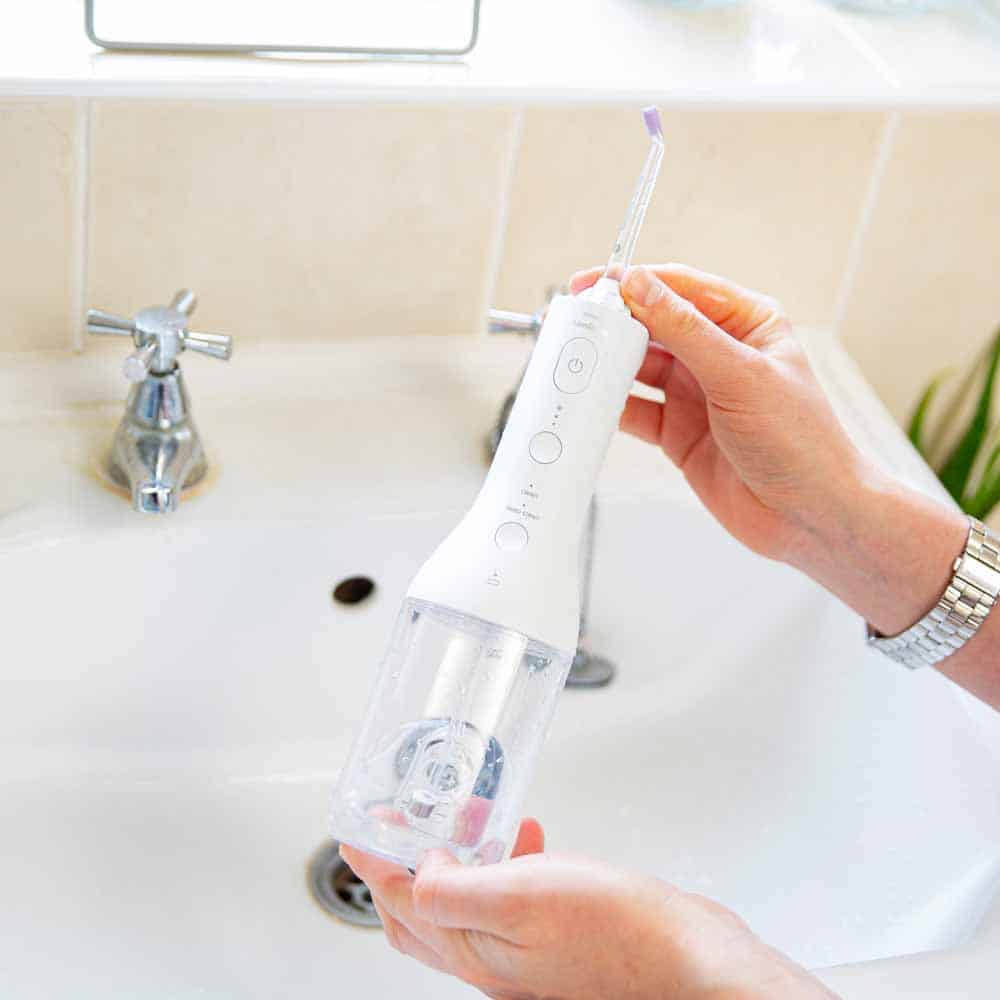
Comparably sized to other cordless models, it is noticeably lighter than the likes of the Waterpik Advanced, by some 2.4oz (70 grams).
The power button has a less pronounced concave design compared to the intensity and mode buttons. All of them can be fairly easily detected by the fingertip and all give some feedback when pressed, if not that satisfying.
Aesthetically there is a lot of similarity with Sonicare toothbrushes, which I like. The 3000 has a clean and minimal look. It’s available in black, white or mint and has a matte finish — there are no gloss plastics like with other models.
The Cordless Power Flosser 3000 does produce up to 77 decibels of sound when in use.
Longer flossing times with the 250ml water reservoir
250ml is the capacity of the reservoir on this flosser. This is a little higher than average, which allows for longer flossing times of 60+ seconds, compared to the 30-45 of most.
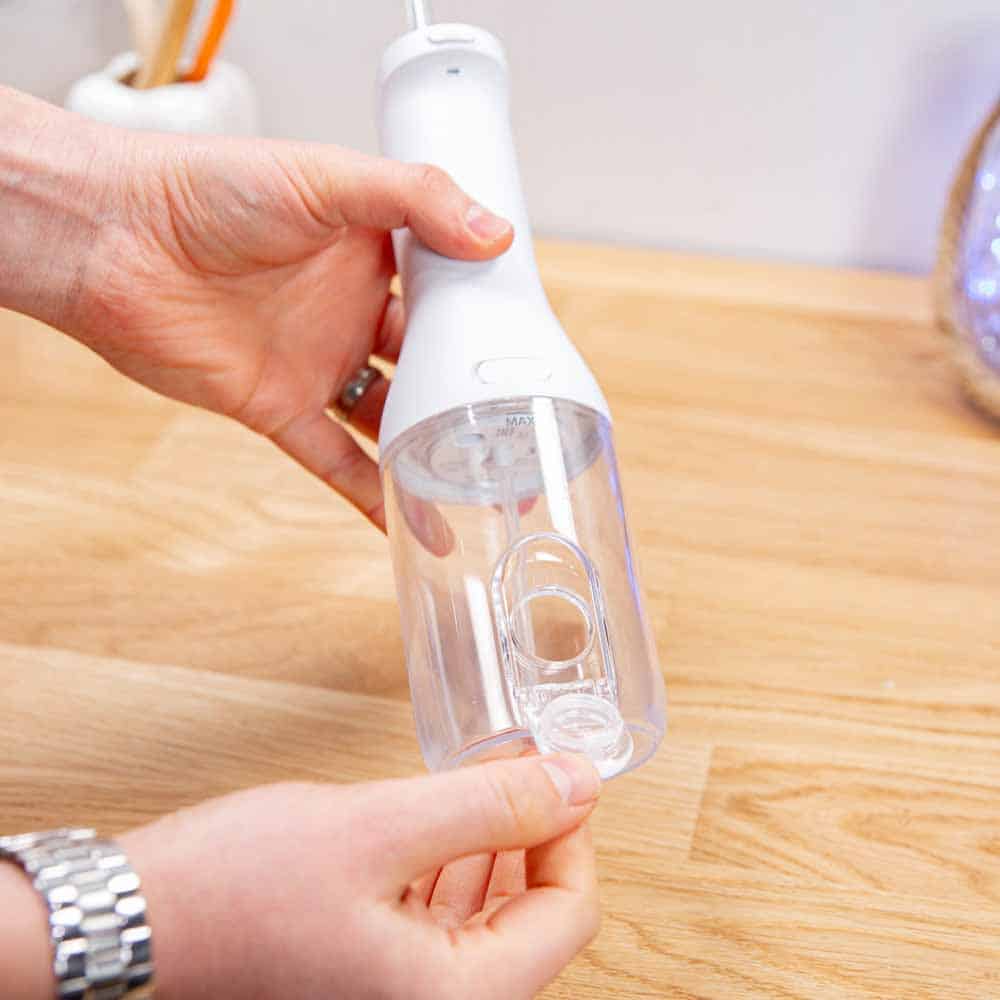
It also means less need to refill the tank, which saves some inconvenience.
The exact running time depends on the cleaning mode and intensity selected.
- Clean mode
- High intensity – 1 minute
- Low intensity – 1 minute and 15 seconds
- Deep clean mode
- High intensity – 1 minute and 5 seconds
- Low intensity – 1 minute and 25 seconds
There are 2 ways to fill the tank. You can either twist and remove it from the handle or open the hinged door on the tank. I think the hinged door is slightly more convenient for everyday use.
The ability to remove the tank entirely makes it easy to clean and dry thoroughly.
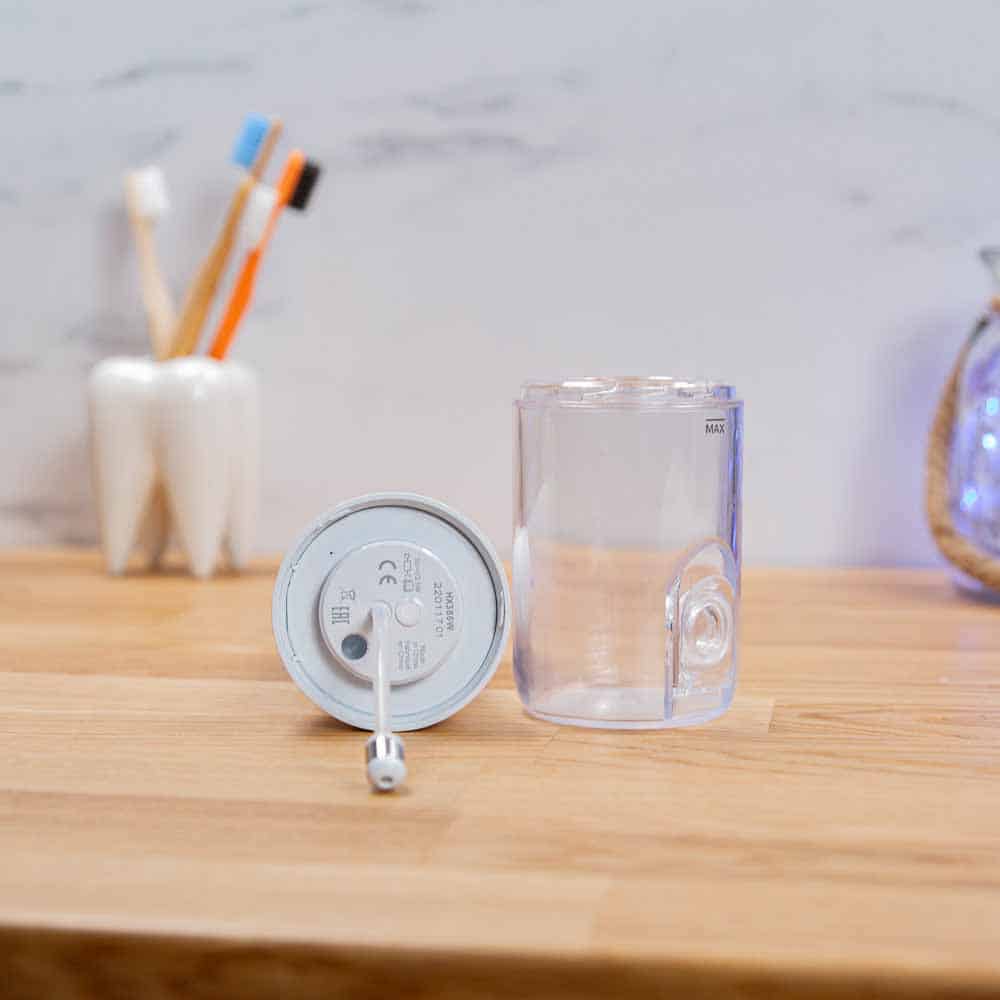
3 intensities and 2 modes – useful, but not a game changer
3 intensities of water flow would have been more than sufficient, but you have the choice of 2 cleaning modes too.
The cleaning modes work slightly differently.
- Clean – This offers a constant water pressure for a great clean.
- Deep clean – The flow of water increases and decreases in intensity. Pulse Wave technology provides a brief pause in the jet of water to allow you to move the nozzle from one space to the next between teeth.
I can’t say I prefer one over the other, they are just different.
The Pulse Wave cleaning action makes it a touch easier to move the nozzle from one interdental space to another, but it isn’t as pronounced as you might expect. There is still a consistent stream of water being pushed through the whole time.
The mode can be changed at any time, using the dedicated mode button. There are LEDs on the handle to show which is selected.
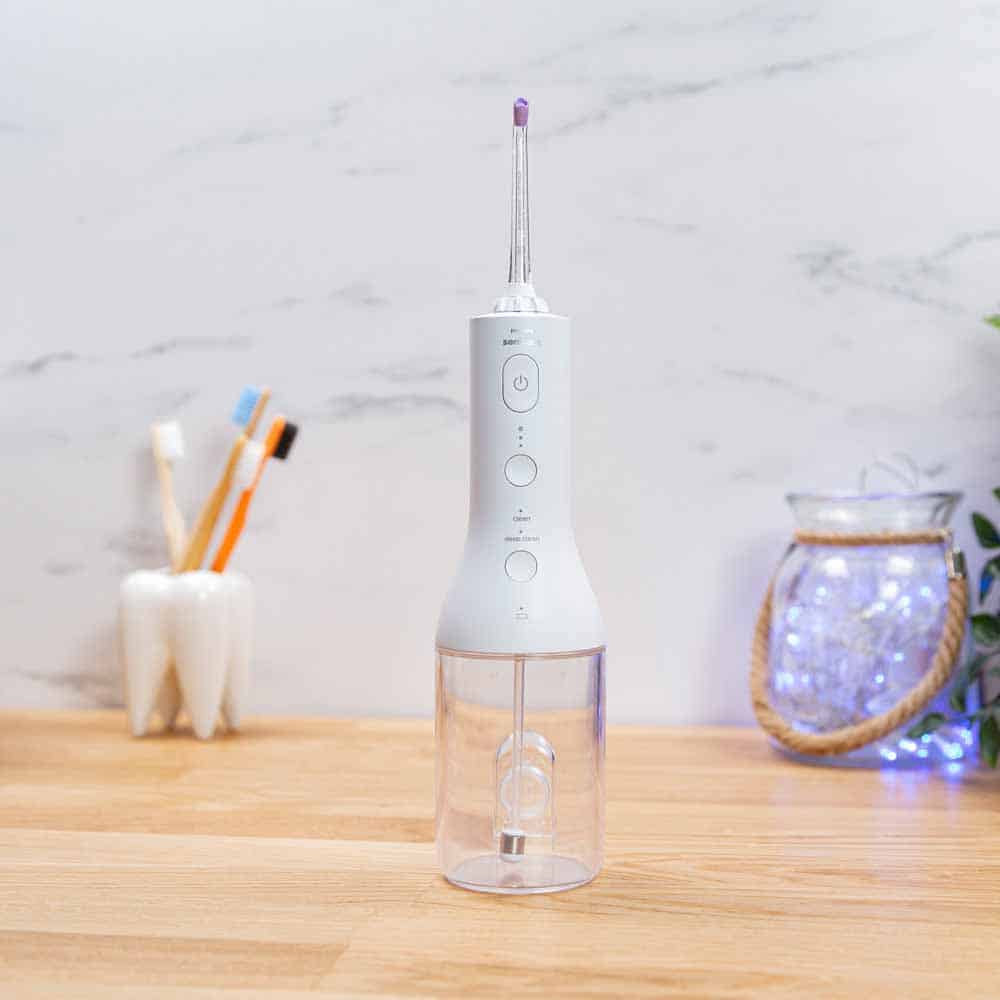
The intensity of the water flow in each mode can be adjusted at any point. There are LEDs on the handle for this too.
- 1 LED – Low intensity
- 2 LEDs – Medium intensity
- 3 LEDs – High intensity
Philips doesn’t publish the PSI for each like competitors might. They are certainly similar to other flossers with multiple intensities. I wouldn’t say that the low is much softer or the high much more intense to make this a must-pick over the competition.
I recommend new water flosser users use the more gentle low mode and increase the intensity over a few weeks.
Power isn’t the key to good results, technique is more important.
The Quad Stream tip is the most impressive of the 3 nozzle designs
Philips has designed 3 different nozzles or flosser tips for its range of water flossers.
Your options are:
- F1 standard
- A standard nozzle with a single stream of water for removing debris and plaque.
- F2 comfort
- A soft rubber nozzle for comfort and ease of positioning for those with sensitive gums.
- F3 quad stream
- A soft rubber nozzle that directs water into a cross shaped (x) stream that gently removes plaque for an effortlessly thorough clean.
All of these nozzles are interchangeable.
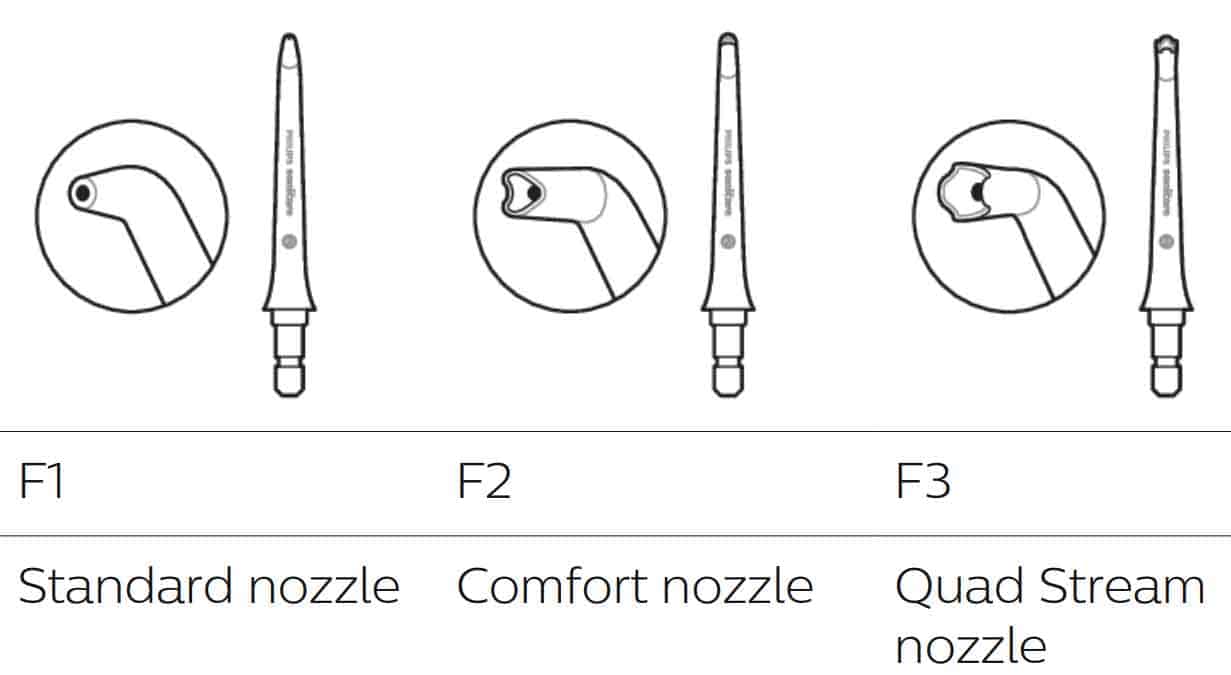
The F1 standard is the style most companies offer with their water flossers. It’s the F3 tip that makes this unique.
The rubber tip of the nozzle causes the water to create an X shape as it comes out of the tip, essentially giving 4 jets with a much wider and larger coverage area.
To me, the X pattern felt a little less intense at times. Other times, it felt more intense depending on where the X hit my gums.
The increased coverage gives a different feel as you clean.
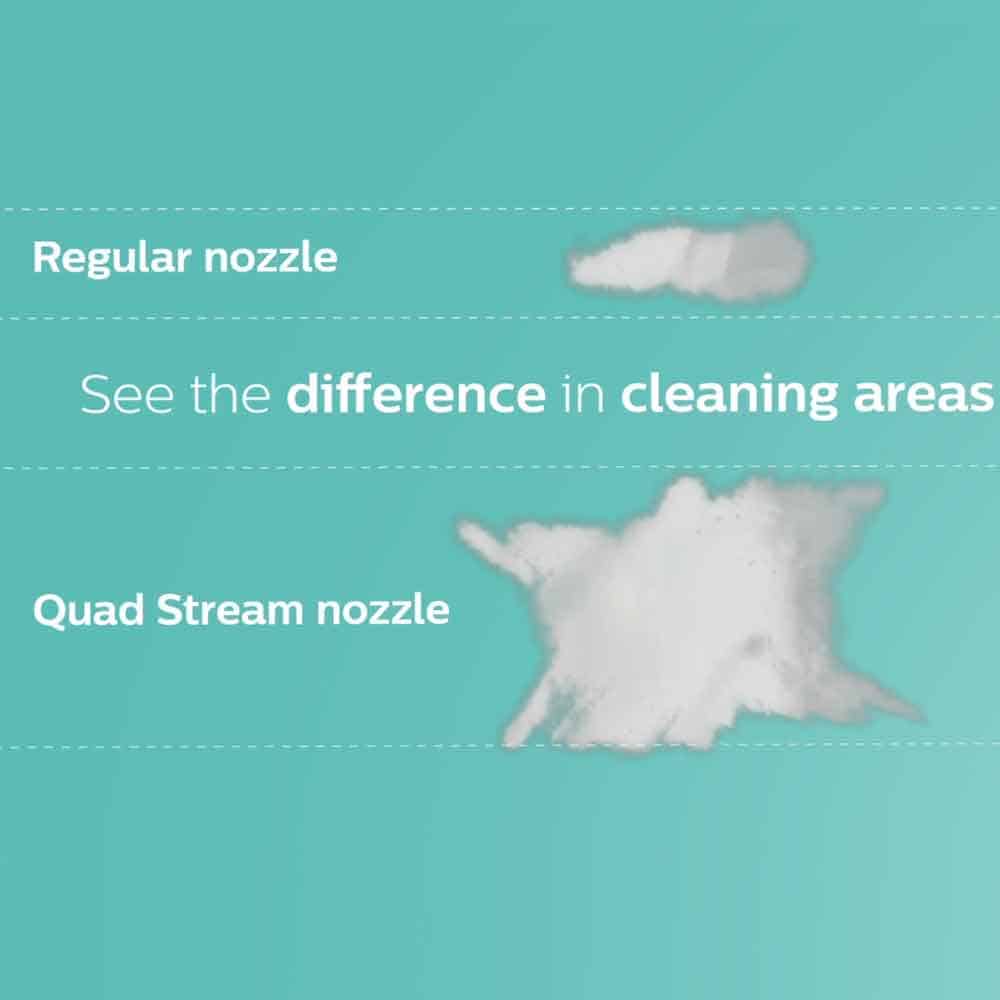
Sonicare’s range of tips is smaller than market leader Waterpik. If you have fixed braces, implants, or bridges, Sonicare doesn’t offer a nozzle with bristles that give the additional mechanical cleaning action, like select Waterpik tips do. It isn’t a deal breaker, the water jet still achieves good results. Fewer choices help reduce confusion and decision fatigue.
The cleaning results are great & clinically proven
My hands-on testing is by no means scientific, but I can’t find a reason to complain about the results I have achieved. I am very pleased. I could feel the difference in my teeth after use and I was amazed at how much debris was left in the sink.
I can’t say it is better or worse than the competition. It’s certainly less hassle than using string floss.
The X shaped water stream that is generated from the F3 quad stream nozzle is very different from the normal jet tip. Yet, for me, the post-use clean feels comparable with either the F1 or F3 nozzles.
Perhaps long term there will be a greater benefit to be gained from the X shaped stream, as some clinical testing by Philips has highlighted.
Philips has conducted various tests with its flosser range, and the cordless 3000 has been proven to remove 99.9% of plaque.
Hopefully, in time we see more independent tests and comparisons to similar products.

The pacer helps you to floss for the right amount of time
An experienced user can thoroughly floss their teeth in around 45 seconds.
Speed isn’t the aim of the game, though — consistency and technique are more important. Taking a bit longer can deliver better results.
The 3000 encourages you to achieve this thanks to its pacer. At 15 second intervals, there is an alert for you to move between the inner and outer surfaces in the upper and lower arches. The idea being you spend 30 seconds per arch.
It continues for up to 120 seconds/2 minutes, at which point it will turn itself off. The reservoir will have long been drained by this point. Not a fan of pacing? It can be disabled.
When using the deep clean mode, you get an added benefit: ‘Pulse Wave technology’. The pressure of the water alternates with a slight pause. The pause is the moment you move from one interdental space to the next. It does exist, but in my opinion, it doesn’t provide quite the seamless water free transition between teeth that you might expect.
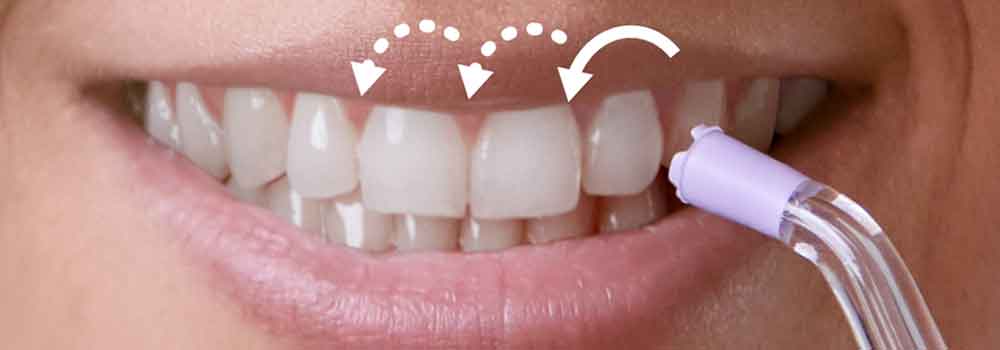
Rotating the nozzle is harder than it should be
Being able to rotate jet tips allows for more accurate control of the water flow and is particularly helpful, in my opinion, when trying to clean the inside surfaces of the teeth.
All of the interchangeable nozzles can be rotated, but doing so when in use is particularly difficult. The mechanism is stiff and far from smooth. Even with the flosser turned off and out of the mouth, it isn’t effortless. Waterpik’s models are far better engineered.
Anyone with dexterity issues best avoid the Cordless 3000.
The travel pouch is a useful accessory
Simple but effective, the black drawstring pouch supplied with the Power Flosser 3000 is a handy accessory to protect the device and stop water from escaping when you are on the go. It is made from a wipe-clean plastic material.
Unlike most flossers, the Cordless 3000 allows a single nozzle to be stored inside the reservoir, by clipping into the base of the unit. Quite innovative.
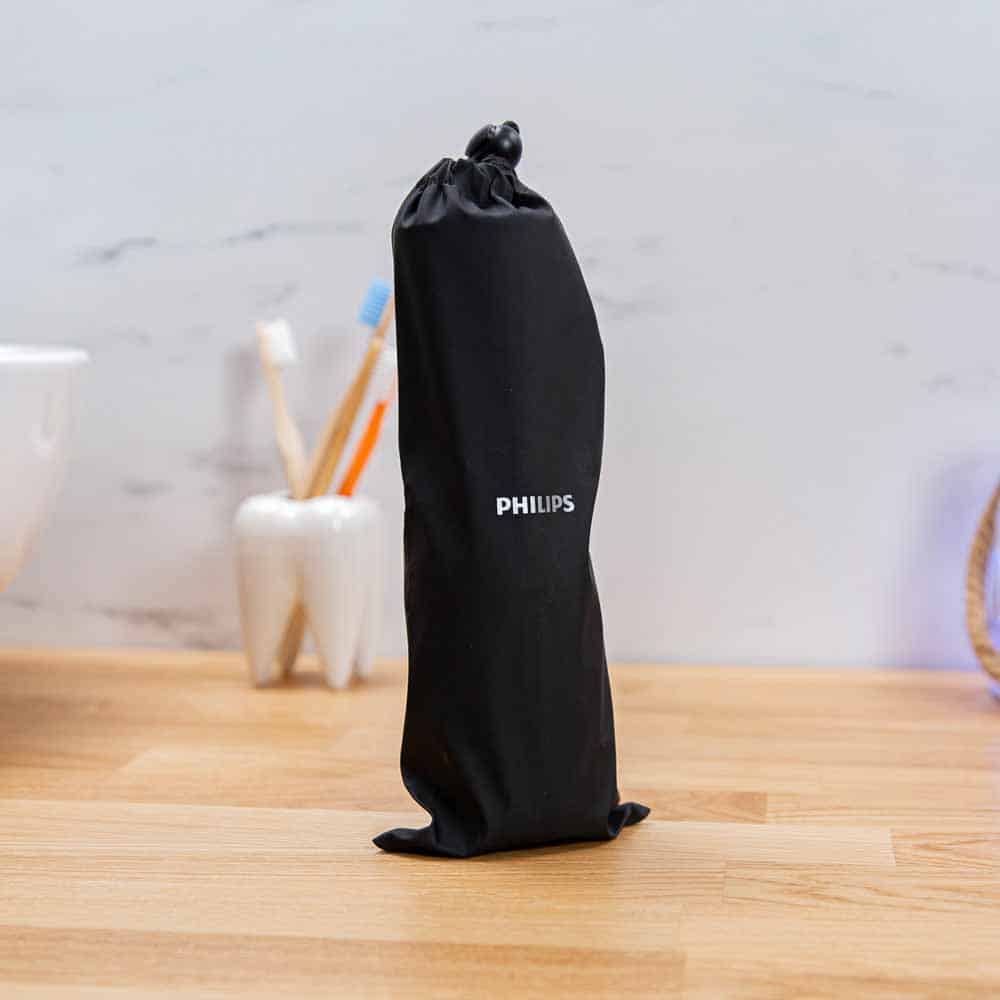
The battery life is 4x better than advertised
54 days of use is what I managed to achieve in my testing of the Cordless 3000. This is very impressive and above the average usage time for a rechargeable cordless flosser. And I was using the most powerful mode.
It is far better than the 14 days claimed on the box and the 25 days stated in the manual.
An LED on the handle gives feedback on the charge level when connected to the charger or not. Unlike many that only alert you when the power is low, it uses different light patterns for different charge levels.
- Full battery – Solid green LED
- Medium battery – Flashing green LED
- Low battery – Flashing amber LED
- Empty – Flashing amber for 5 seconds and the power flosser turns off automatically
- Charging battery – Flashing green LED
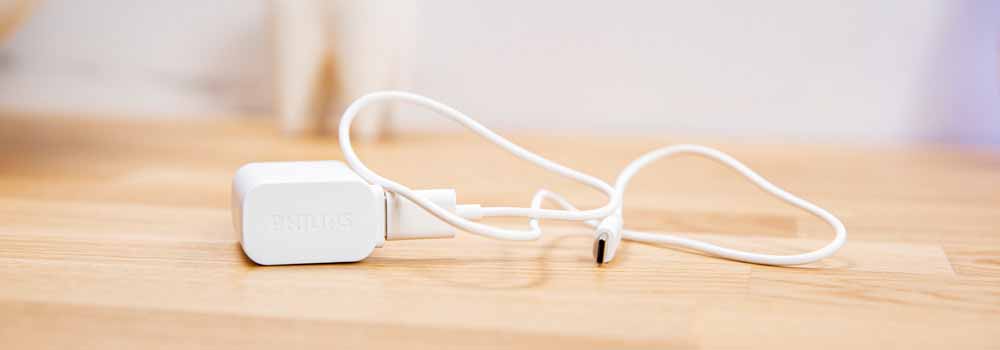
USB Type C charging
Recharging of the Lithium-Ion (Li-Ion) battery, sealed inside the handle is achieved via the provided USB Type A to USB Type C cable.
A Type C charging port on the back of the flosser is accessible by removing the rubber cover that fits into it to protect against water ingress.
Whilst I would prefer not to have to deal with fiddly little port covers, this is one of the better configurations. The cover is physically attached and there is enough play that it does not get put under too much strain.
A USB to 2 pin power adapter supporting 100-240v is supplied, so that you can connect it to a power outlet.
It’s somewhat surprising this is included given the 2100 and 3100 Series toothbrushes don’t come with one based on reducing environmental impact. What’s different here?
If you’d rather, it can be charged from other USB power sources such as a computer or battery bank.
A full charge can take up to 8 hours.
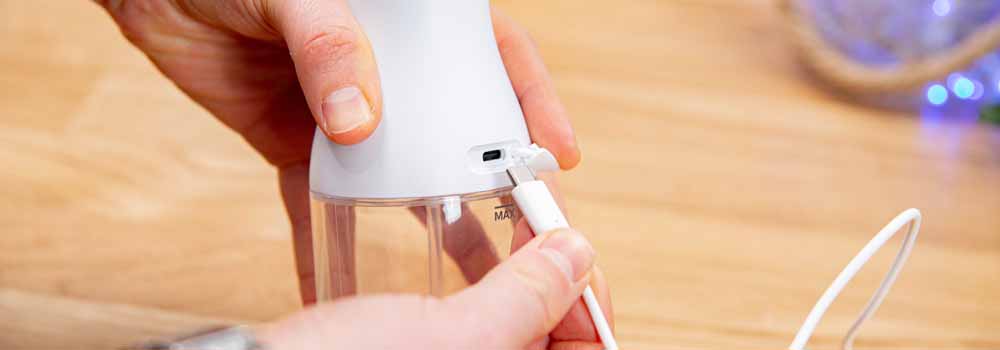
Competitively priced to comparable flossers
The Cordless 3000 has a recommended retail price of $189 but sells on average for around $150.
It’s about $50 cheaper than the similarly featured Cordless Advanced from Waterpik.
However, ownership costs over 3 years are very comparable. The Cordless 3000 costs around $250 compared to the $236 of the Advanced.
Sonicare nozzles cost about $20 a time vs. the $9 Waterpik tips.
My slight preference is the Waterpik, but there is little between the two.
No user-serviceable parts and an industry average 2 year warranty
2 years is the warranty period of the Cordless Power Flosser 3000, which is on par with other brands.
Sonicare hasn’t gone above and beyond here, and neither has it made repairability easier. There are no user-serviceable parts to this device. In other words, you can’t fix it yourself.
It feels solid and durable, and upon inspection, everything appears to be designed with longevity in mind. There’s a strong seal on the reservoir door and a nice flexibility to the USB port cover. I’ve no reason to be concerned about long term durability.
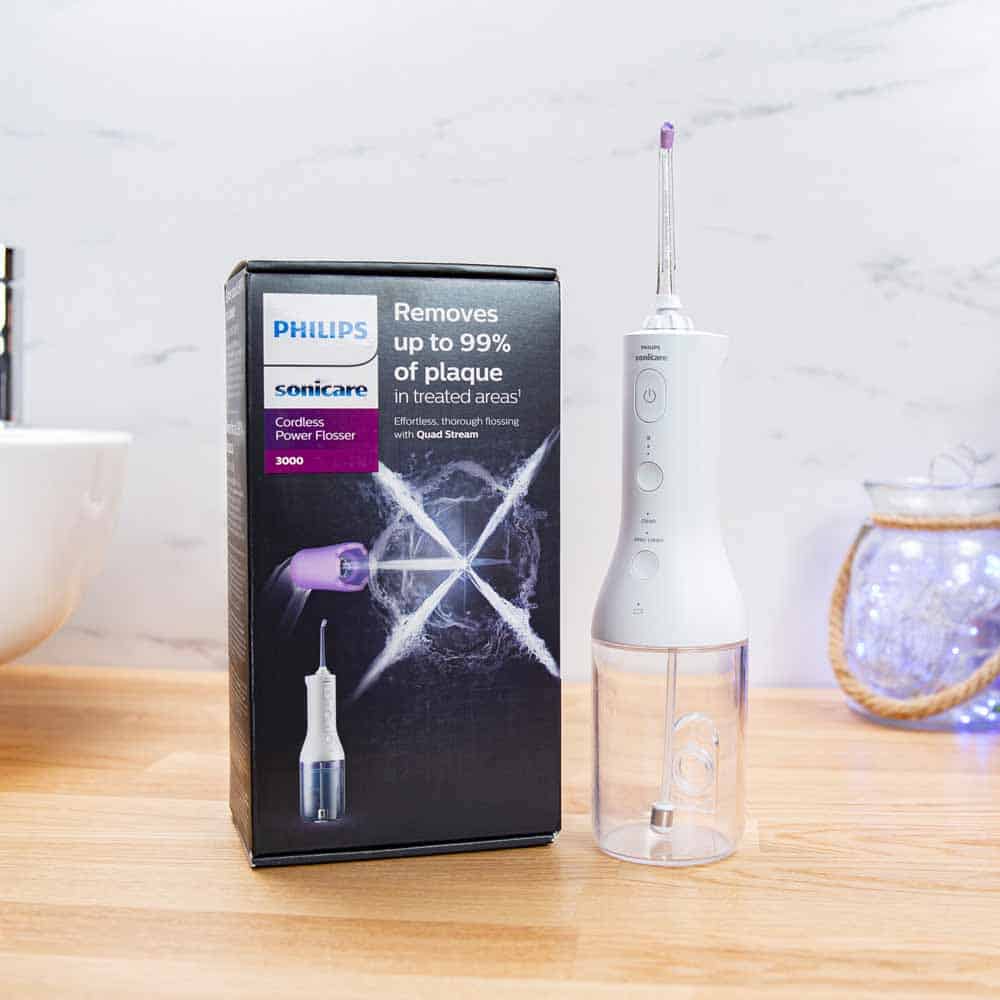
Environmental impact
As it stands, there haven’t been any studies to specifically measure the environmental impact of water flossers.
However, a 2020 study found that an electric toothbrush has around 11 times the environmental impact of a manual toothbrush. The equivalent is likely to be true of a water flosser compared to
string floss or interdental brushes.
If you can use string floss or interdental brushes, it will be better for the planet than opting for the Cordless 3000. It is interdental brushes that are the most effective of all flossing tools.
With regards to the Cordless 3000 specifically, it isn’t packed with lots of unnecessary extras. The USB charging cable can be repurposed.
Petroleum-based plastics are used, rather than plant-based, thus using more of the planet’s finite resources.
Unfortunately, Philips doesn’t currently offer any recycling programme for their flossers or consumables.
Conclusion: premium performance from a premium brand
This is an excellent cordless water flosser. You wouldn’t know it’s Sonicare’s first attempt at making one.
I don’t think it is as comfortable in the hand, or as easy to use, as the Waterpik Cordless Advanced. Rotating the nozzle in use is much more difficult.
But, it is a very good alternative. The pacer, larger water reservoir and USB type c charging are arguably better.
If you are looking for a cordless water flosser, you could do a whole lot worse.
Size guide
- Water Flosser Height With Nozzle - 30.8cm / 12.1 inches
- Width - 6.5cm / 2.6 inches
- Depth/thickness - 6.5cm / 2.6 inches
- Weight with nozzle (no water) - 289g / 9.6oz
- Package weight - 600g / 21.2oz
Noise
- 77dB
Country of manufacture
- China
FAQ
- How to activate or deactivate the pacer on the cordless 3000?
- With the Cordless Power Flosser off, press and hold the intensity selection button for 3 seconds.
- When deactivated, the battery indicator light will flash amber once.
- When activated, the battery indicator light will flash green twice.
Disclaimer
The Sonicare Cordless Power Flosser 3000 spoken about in this review was provided by Philips PR department. Electric Teeth did not purchase this model. No financial reward was provided to conclude the review the way that we did and Philips had no editorial control over the content.



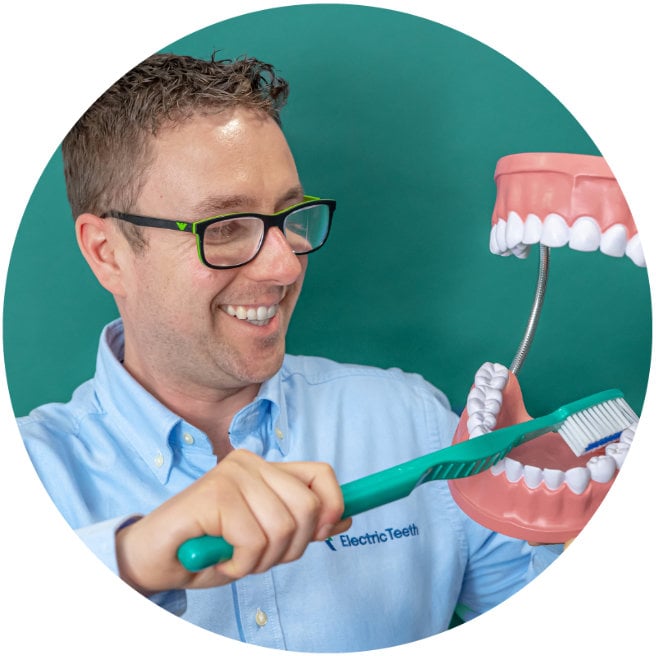
my sonicare 3000 is 6 months old. i reside in Kenya and I had bought this unit from Carre four in Dubai,
its worked fine till 2 weeks ago.
its got a problem. its not staying on. when i press the power button it works, one squart and stops. what can be the cause?
Hi Nazir. I am afraid I am not an engineer to say what is going wrong, but it is clear this isn't normal behaviour and will need to be returned to the seller or Sonicare.